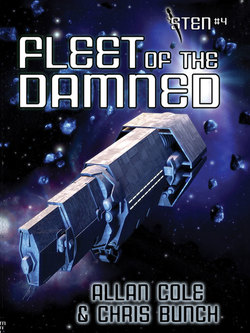Читать книгу Fleet of the Damned (Sten #4) - Allan Cole - Страница 18
На сайте Литреса книга снята с продажи.
ОглавлениеCHAPTER THIRTEEN
THE LABEL “the Fringe Worlds” suggests some sort of geographical or political cohesiveness to the spattered cluster that occupied space between the Empire and the Tahn System. There was almost none.
The cluster had been slowly settled by Imperial pioneers. They were not the radicals or the adventurers who had explored, for instance, the Lupus Cluster. They were people wanting things to be a little more simple and peaceful. A large percentage of them were retired military or civil servants starting a second, or even third, career. Others wanted a chance to establish themselves in comfort as small manufacturers or business people.
But if there were no hero pioneers, there also were none of the villains that pioneering creates. Not, at least, until the expansion from the Tahn empire brought new, and somewhat different, immigrants.
What government there was in the Fringe Worlds mirrored the settlers themselves. Whether confined to a single world or including a half dozen or so systems, it was generally some species of parliamentarianism, ranging from mildly liberal to mildly authoritarian. Since prospective tyrants went elsewhere, what armed forces existed were somewhere between customs police and coastal guards. The only unifying political force the cluster had was an economic summit that met to iron out modern problems every five years or so. It was a backwater cluster, content to remain as it was.
Until the Tahn.
The Tahn who immigrated into the Fringe Worlds were financially backed by their leaders, as the Tahn birth rate and political ambitions clamored for Lebensraum. These were true pioneers, looking for more. Since their culture encouraged communal economics, they naturally had an advantage over the ex-Imperialists. And so the situation escalated into violence—riots and pogroms.
The Imperial settlers were there first, so they had a chance to modify the government. Tahn were not permitted extensive freeholds. They were excluded from voting. They were physically ghettoized into enclaves either rural or urban.
The Tahn settlers’ resentment was fed by the Tahn Empire itself, which wanted the cluster added to its holdings.
The revolutionary movement was not only popular but well backed by the Tahn. And the Empire had done little to solve the problem. After all, backwater areas with minor problems—riots, no matter how bloody, are not as bad as active genocide—get minor attention.
The Imperial garrisons assigned to the Tahn worlds were fat and lazy. Instead of being peacekeepers, the officers and men tended to agree with the settlers. The Tahn, after all, were different—which meant “not as good as.”
There had been a brief time, not long before, when the confrontation between the Empire itself and the Tahn might have been prevented. Some of the more farsighted Tahn revolutionaries had recognized that if the confrontation occurred, they were liable to be crushed in the middle. Very secretly they had sent the head of the organization to Prime World.
Godfrey Alain had been murdered in a plot that was aimed against the Emperor himself. Final negotiations between the Empire and the peace faction of the Tahn Council had also ended in blood.
The war drums were not even slightly muted, especially on the Fringe Worlds.
But no one in the cluster seemed to know how close Empire wide war was.
